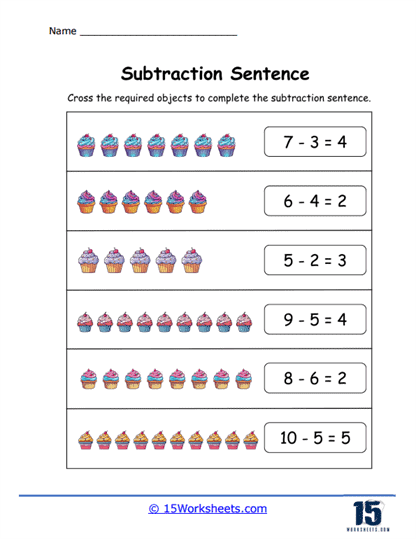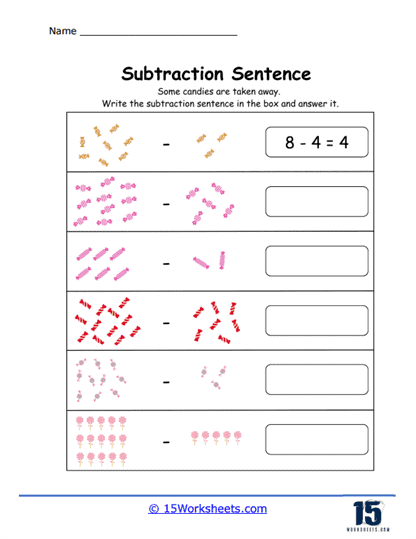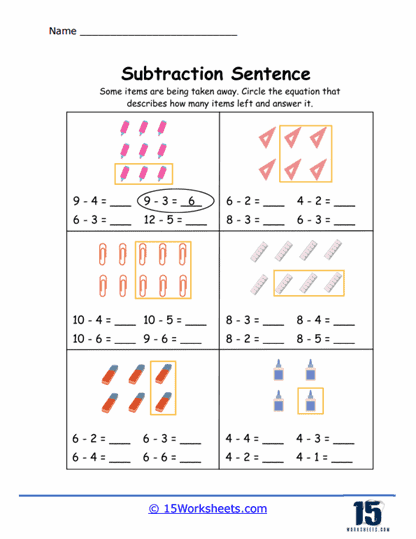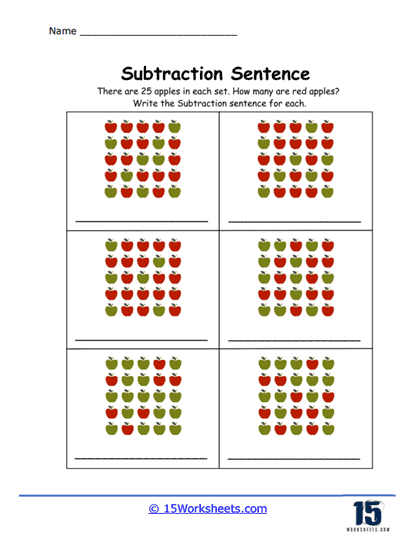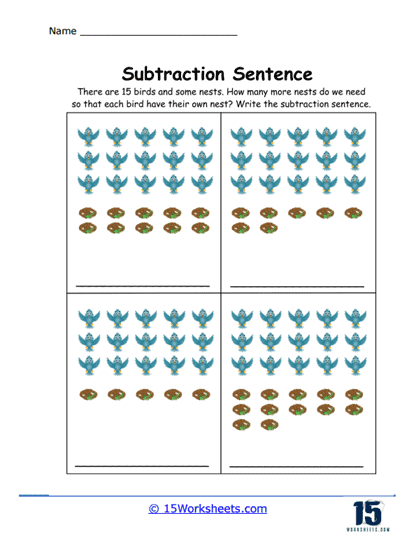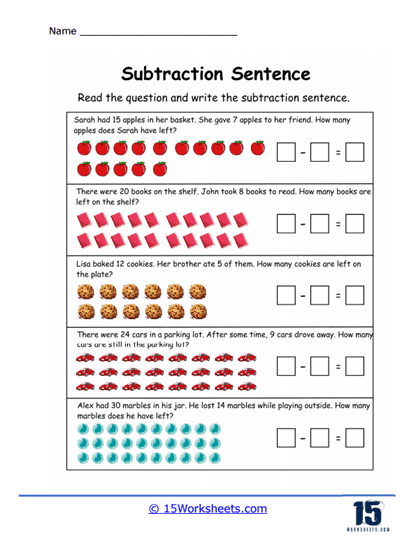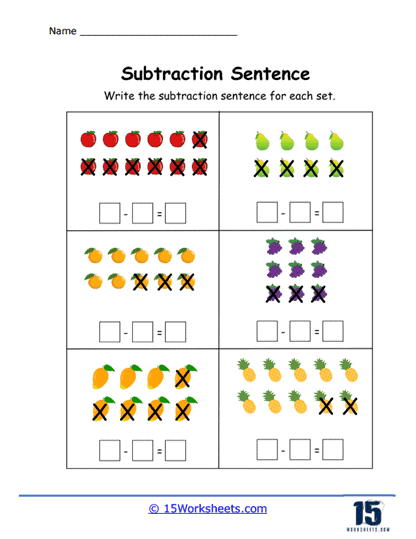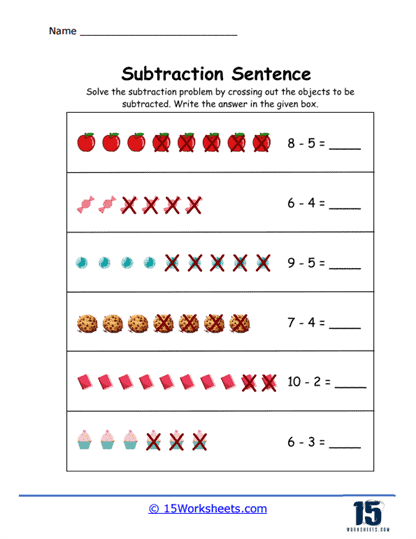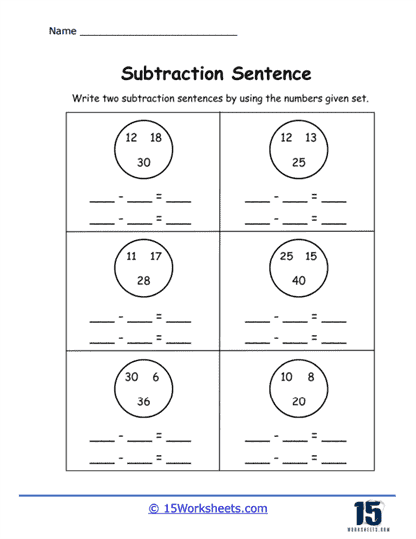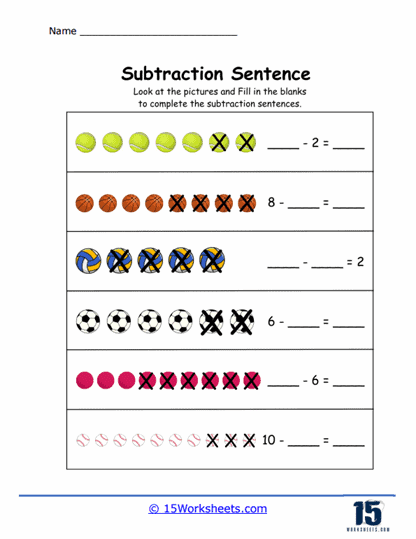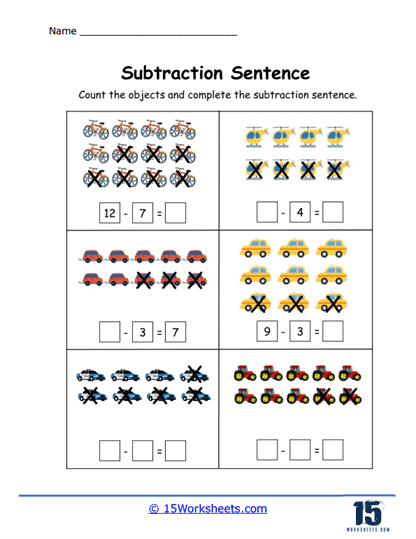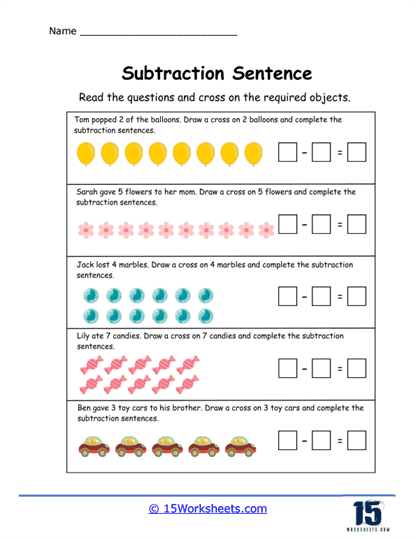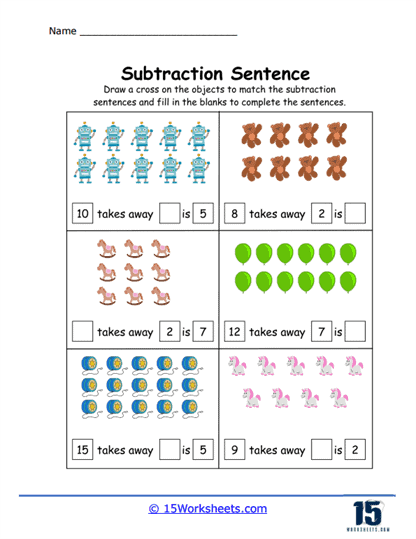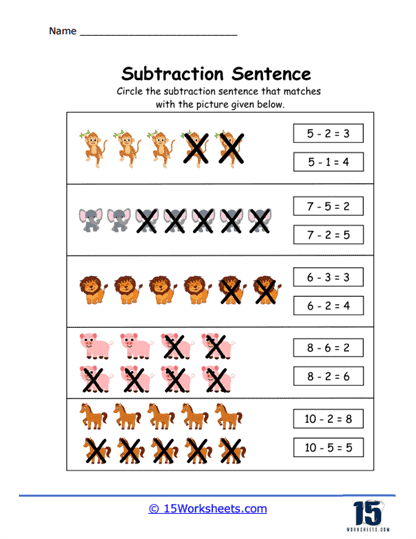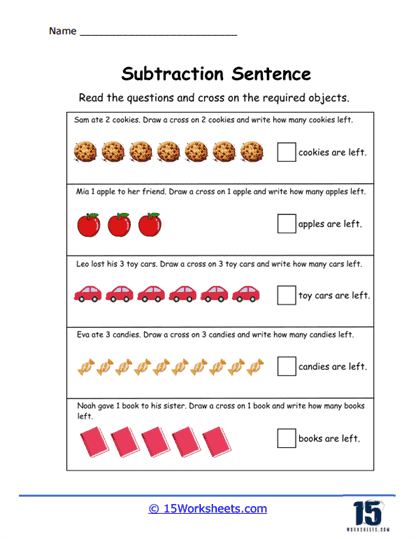Subtraction Sentence Worksheets
About These 15 Worksheets
These worksheets will help students develop and practice their subtraction skills by forming subtraction equations or “sentences” from given situations or images. These worksheets serve as a bridge between abstract numerical problems and real-world applications, making the learning process more engaging and interactive for young learners. By providing various visual aids, scenarios, and exercises, these worksheets foster both foundational arithmetic skills and critical thinking abilities.
One of the common types of subtraction sentences worksheets involves crossing out a certain number of objects to match a provided subtraction equation. In these exercises, students see a set of objects-such as cupcakes, apples, or candies-and are asked to cross out a specific number based on the given equation (e.g., “7 – 3 = 4”). The visual component helps students associate the concept of taking away with subtraction, making the abstract operation more tangible. This type of worksheet is particularly useful for early learners who are just beginning to understand subtraction. The act of crossing out objects reinforces the idea of “taking away,” providing a visual confirmation of what is happening in the subtraction equation. The skills taught here include counting, subtracting from a known set, and understanding the basic structure of a subtraction problem.
Another variation of subtraction sentence worksheets requires students to look at a group of images, like various fruits or toys, and write the correct subtraction sentence that matches the visual representation. For example, a set of balloons might show that a certain number of balloons have been crossed out, and the student is expected to write an equation, such as “8 – 2 = 6,” to represent what has occurred. This type of activity encourages students to practice forming equations on their own, rather than simply solving them, which strengthens their ability to translate visual information into mathematical expressions. The skills emphasized here include the formation of subtraction sentences, visual representation of mathematical concepts, and number writing.
In some subtraction sentence worksheets, students are given word problems where they must read a scenario and write the corresponding subtraction sentence. For example, a problem may describe Sarah giving away apples or a car driving away from a parking lot, and the student must determine how many items remain and write the subtraction sentence. This type of worksheet blends literacy with mathematics, as students must understand the language of the problem before they can solve it. It encourages critical thinking, as students must decide which numbers to subtract and in what order. The ability to dissect a word problem and extract the necessary information is a crucial math skill, and this type of worksheet provides valuable practice in that area.
There are also worksheets where students are provided with visual representations of grouped objects but must draw the correct number of crosses on the objects themselves to complete the subtraction sentence. These worksheets often present objects such as toys, fruits, or other themed items and ask students to actively engage in the problem by marking the items that should be subtracted. After marking them, students complete the corresponding subtraction sentence (e.g., “10 toys take away 3 = 7”). This hands-on activity helps solidify the concept of subtraction as a process of taking away, which is a key building block in early mathematics education. It also teaches fine motor skills and attention to detail, as students must accurately mark the correct number of items.
In a more advanced version of these worksheets, students are given a set of numbers in a circular or grid format and asked to create two or more subtraction sentences using those numbers. For example, they might be given the numbers 30, 12, and 18, and tasked with writing two different subtraction sentences that use these numbers. This type of exercise encourages flexibility in thinking and helps students recognize that subtraction can happen in multiple ways, using the same set of numbers. It emphasizes the relationships between numbers and helps students see that subtraction is not a one-way operation but can be approached from different angles. The skills developed through these exercises include problem-solving, flexibility in mathematical thinking, and reinforcement of basic subtraction facts.
Some worksheets also challenge students by requiring them to match subtraction sentences to corresponding pictures. Students might see a row of pictures with crossed-out objects and a set of subtraction sentences, and their task is to match each picture with the correct equation. This exercise reinforces the connection between visual subtraction and numerical representation. It also encourages careful observation and attention to detail, as students must correctly interpret both the visual cues and the mathematical sentence. The matching activity sharpens both visual and cognitive skills, allowing students to practice subtraction in a more interactive format.
For students who are ready to take on more complex subtraction sentences, there are worksheets that combine both visual and numerical elements with a greater level of difficulty. These might involve multi-step problems or require students to solve for a missing number in the subtraction sentence. For example, a worksheet might display a group of candies, some of which are crossed out, and the student must determine how many candies were originally there by solving a reverse subtraction problem. This type of worksheet encourages algebraic thinking, as students begin to solve for unknowns within an equation. It also teaches them to think critically about the relationship between numbers and to explore subtraction from different perspectives.
What Are Subtraction Sentences?
A subtraction sentence is a mathematical expression or equation that clearly shows the process of subtraction, including the numbers involved and the operation being performed. Essentially, it communicates the act of “taking away” one quantity from another and arriving at a result. A subtraction sentence always contains three key parts – the minuend, the subtrahend, and the difference.
Components of a Subtraction Sentence: Minuend – Subtrahend = Difference
Minuend – This is the starting number or the total from which a quantity is being subtracted. It’s the number that is “larger” or “whole” before any subtraction takes place. In the sentence “8 – 3 = 5”, the minuend is 8. The minuend represents the total amount before something is taken away.
Subtrahend – This is the number being subtracted from the minuend. It represents the amount or quantity that is removed. Using the same example, “8 – 3 = 5”, the subtrahend is 3. The subtrahend shows how much is being taken away from the original quantity (minuend).
Difference – This is the result or outcome of the subtraction process. It is the value you are left with after the subtrahend is taken away from the minuend. In “8 – 3 = 5”, the difference is 5. The difference represents what remains after the subtraction has occurred.
For example – In the subtraction sentence – 12 – 4 = 8
Minuend – Subtrahend = Difference
Minuend – 12
Subtrahend – 4
Difference – 8

